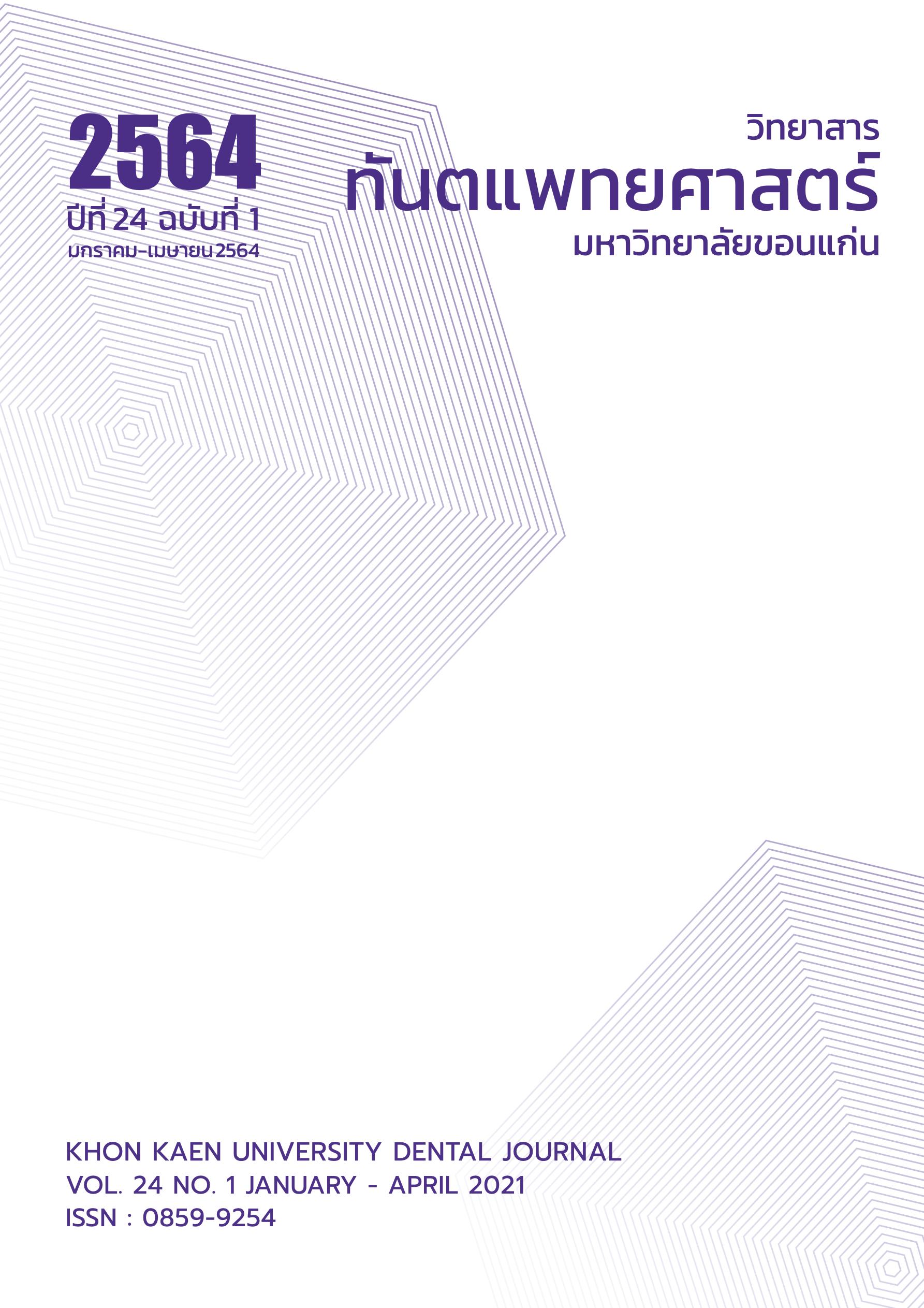Radiopacity of 9 Clear Resin Cements and Zinc Phosphate Cement
Main Article Content
Abstract
The aim of this study was to compare radiopacity value of 9 clear resin cements and zinc phosphate cement. Ten group of specimens were divided by commercial brand. Disc specimens (diameter: 6 mm and thickness: 1 mm) were fabricated by manufacturer’s instruction (n=10). The samples and aluminum step wedge used as standard for radiologic analysis were placed on X-ray sensor. They were digitally radiographed together and the digital radiographic images were then analyzed with ImageJ program. The relationship between the gray value for each specimen and the aluminium step wedge thickness were plotted and transferred. The data were analyzed by One-way ANOVA and Tukey’s post-hoc test at p<0.05. Zinc phosphate cement showed the highest radiopacity value among 10 dental cement groups. For the resin cements, Nexus 3 demonstrated the highest radiopacity value followed by Variolink® Esthetic LC which was no statistically significant difference to Variolink® Esthetic DC, Panavia V5 and Panavia SA luting. Moreover, Rely™ X Veneer was the lowest radiopacity value but it was no statistically significant difference to Rely™ X Ultimate Clicker. However, Superbond C&B and Temp-Bond Clear showed radiolucent. In conclusion, there were statistically significant among 10 groups of cement in which zinc phosphate cement showed the highest radiopacity value.
Article Details
บทความ ข้อมูล เนื้อหา รูปภาพ ฯลฯ ที่ได้รับการลงตีพิมพ์ในวิทยาสารทันตแพทยศาสตร์ มหาวิทยาลัยขอนแก่นถือเป็นลิขสิทธิ์เฉพาะของคณะทันตแพทยศาสตร์ มหาวิทยาลัยขอนแก่น หากบุคคลหรือหน่วยงานใดต้องการนำทั้งหมดหรือส่วนหนึ่งส่วนใดไปเผยแพร่ต่อหรือเพื่อกระทำการใด ๆ จะต้องได้รับอนุญาตเป็นลายลักษณ์อักษร จากคณะทันตแพทยศาสตร์ มหาวิทยาลัยขอนแก่นก่อนเท่านั้น
References
White SC, Pharoah M, editors. Oral Radiology: Principles and Interpretation. 7thed. St. Louis: Elsevier, 2014:131-52.
Braga RR, Mitra SB ln:Powers JM, Sakaguchi RL. Craig’s Restorative Dental Materials.13thed. Philadelphia, Elsevier, 2012:327-44.
Bayindir F, Koseoglu M. The effect of restoration thickness and resin cement shade on the color and translucency of a high-translucent monolithic zirconia. J Prosthet Dent 2020;123(1):149-54.
Fonseca RB, Branco CA, Soares PV, Correr-Sobrinho L, Haiter-Neto F, Fernandes-Neto AJ, et al. Radiodensity of base, liner and luting dental materials. Clin Oral Investig 2006;10(2):114-8.
Pekkan G, Özcan M. Radiopacity of different resin-based and conventional luting cements compared to human and bovine teeth. Dent Mater J 2012;31(1):68-75.
Feitosa FA, Oliveira M, Rodrigues JA, Cassoni A, Reis AF.Comparison of the radiodensity of luting materials. Rev Odontol UNESP 2011; 40(6): 285-9.
Montes-Fariza R, Monterde-Hernández M, Cabanillas-Casabella C, Pallares-Sabater A. Comparative study of the radiopacity of resin cements used in aesthetic dentistry. J Adv Prosthodont 2016;8(3):201-6.
Furtos G, Baldea B, Silaghi-Dumitrescu L, Moldovan M, Prejmerean C, Nica L. Influence of inorganic filler content on the radiopacity of dental resin cements. Dent Mater J 2012;31(2):266-72.
Watts DC. Radiopacity versus composition of some barium and strontium glass composites. J Dent 1987; 15(1):38-43.
Taira M, Toyooka H, Miyawaki H, Yamaki M. Studies on radiopaque composites containing ZrO2-SiO2 fillers prepared by the sol-gel process. Dent Mater 1993; 9(3):167-71.
Wadhwani C, Hess T, Faber T, Piñeyro A, Chen CSK. A descriptive study of the radio-graphic density of implant restorative cements. J Prosthet Dent 2010; 103(5):295-302.
Schneider CA, Rasband WS, Eliceiri, KW. NIH Image to ImageJ: 25 years of image analysis. Nat Methods 2012;9(7):671-5.
Gu S, Rasimick BJ, Deutsch AS, Musikant BL. Radiopacity of dental materials using a digital X-ray system. Dent Mater 2006;22(8):765-70.
Williams JA, Billington, RW. A new technique for measuring the radiopacity of natural tooth substance and restorative materials. J Oral Rehabil 1987;14(3):267-9.
Hosney S, Abouelseoud HK, El-Mowafy O. Radiopacity of resin cements using digital radiography. J Esthet Restor Dent 2017;29(3):215-21.
Reis JM, Jorge EG, Ribeiro JG, Pinelli LA, Rached FO, Filho MT. Radiopacity evaluation of contemporary luting cements by digitization of images. ISRN Dent 2012;2012:704246. Epub2012 Sep13.
Matsumura H, Sueyoshi M, Tanaka T, Atsuta M. Radiopacity of dental cements. Am J Dent 1993;6(1): 43-5.
Tsuge T. Radiopacity of conventional, resin-modified glass ionomer, and resin-based luting materials. J Oral Sci 2009;51(2):223-30.
Nielsen CJ. Effect of scenario and experience on interpretation of mach bands. J Endod 2001;27(11): 687-91.
Berry HMJ. Cervical burnout and Mach band: two shadows of doubt in radiologic interpretation of carious lesions. J Am Dent Assoc 1983;106(5):622-25.
Junqueira R, Carvalho R, Yamamoto F, Almeida S, Verner F. Evaluation of radiopacity of luting cements submitted to different aging procedures. J Prosthodont 2018;27(9):853-59.
Collares FM, Ogliari FA, Lima GS, Fontanella VR, Piva E, Samuel SM. Ytterbium trifluoride as a radiopaque agent for dental cements. Int Endod J 2010;43(9):792-7.
Toyooka H, Taira M, Wakasa K, Yamaki M, Fujita M, Wada T. Radiopacity of 12 visible-light cured dental composite resins. J Oral Rehabil 1993;20(6):615-22.
Bowen RL, Cleek GW. X-ray-opaque reinforcing fillers for composite materials. J Dent Res 1969;48(1):79-82.
Bowen RL, Cleek GW. A new series of X-ray-opaque reinforcing fillers for composite materials. J Dent Res 1972;51(1):177-82.
Ergücü Z, Türkün LS, Onem E, Güneri P. Comparative radiopacity of six flowable resin composites. Oper Dent 2010;35(4):436-40.


